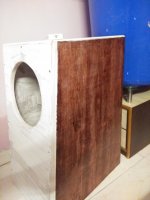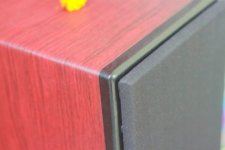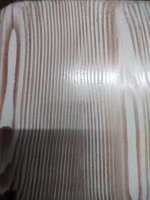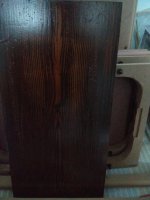Hi,
I am making Paul Carmody's tarkus with MDF.
Wanted some help/ advice on process and finishing techniques.
I wanted the speakers to have wood grain finish. Here is how I am planning to do it.
1. Sand the mdf boxes with 180 grit lightly and wipe with cloth dipped in thinner and let it dry.
2. apply "solvent based" wood primer with a paint roller and let it dry.
3.sand with 220 grit and wipe clean with dry cloth
4. apply "white cement based water soluble" putty with a putty knife and let it dry
5. sand with 220 grit and wipe clean with dry cloth
6. Apply second coat of solvent based wood primer with paint roller and let it dry.
7. sand with 220 grit and then 400 grit and wipe clean.
8. apply first coat of "Rustoleum 1 step wood stain and polyurethane-red mahogany" with a roller.
9. immediately use wood grainer tool with a rocking motion to get wood grain effect.
10. wait for 10-15 minutes and then with a soft bristle brush, lightly run it along the grains to slightly smudge the grains so it looks natural.
11. let it dry for 4-6 hours and then apply second coat of "Rustoleum 1 step wood stain and polyurethane-red mahogany"
12. let it dry completely.
attached is a photo of how it looks on one face and also attached is the primer and PU datasheets.
Now I have following doubts.
1. whether white cement based putty will come off eventually as its water based?
2. whether second coat of solvent based primer will react with polyurethane?
3. any tips on how to merge the grains at the edges and corners so it doesnt look odd
regards
Prasi
I am making Paul Carmody's tarkus with MDF.
Wanted some help/ advice on process and finishing techniques.
I wanted the speakers to have wood grain finish. Here is how I am planning to do it.
1. Sand the mdf boxes with 180 grit lightly and wipe with cloth dipped in thinner and let it dry.
2. apply "solvent based" wood primer with a paint roller and let it dry.
3.sand with 220 grit and wipe clean with dry cloth
4. apply "white cement based water soluble" putty with a putty knife and let it dry
5. sand with 220 grit and wipe clean with dry cloth
6. Apply second coat of solvent based wood primer with paint roller and let it dry.
7. sand with 220 grit and then 400 grit and wipe clean.
8. apply first coat of "Rustoleum 1 step wood stain and polyurethane-red mahogany" with a roller.
9. immediately use wood grainer tool with a rocking motion to get wood grain effect.
10. wait for 10-15 minutes and then with a soft bristle brush, lightly run it along the grains to slightly smudge the grains so it looks natural.
11. let it dry for 4-6 hours and then apply second coat of "Rustoleum 1 step wood stain and polyurethane-red mahogany"
12. let it dry completely.
attached is a photo of how it looks on one face and also attached is the primer and PU datasheets.
Now I have following doubts.
1. whether white cement based putty will come off eventually as its water based?
2. whether second coat of solvent based primer will react with polyurethane?
3. any tips on how to merge the grains at the edges and corners so it doesnt look odd
regards
Prasi
Attachments
I have done a lot of woodworking but have never tried to simulate wood grain. Maybe few others have either? Reading your description I was skeptical but the picture looks good. The putty wood filler will probably be several applications with sanding between to get it perfect, then I would add many many coats of automotive primer with sanding. It takes a lot of work to hide the joints perfectly. I doubt that you will have any issues with the materials adhering to each other, although I've heard one should gntypically avoid putting oil based on top of water based. Good luck!
Reading your description I was skeptical but the picture looks good.
Same here, and I agree it does look good!
A lot of work and processes though - have you considered applying a veneer instead?

I like it, looks good. I can only assume as you do it more, you'll only get better at it.
As for finishing MDF... it's an art all on its own. The biggest issue I have is "telegraphing"... over time, it would seem that the seams will come to show themselves.
I have a project that I used shellac based primer on - After about 18 months of sitting without final topcoat, a previously flat sanded area has given up its dirty secret, and the joint line can be quite easily seen. I used Bondo and sanded flat prior to priming. Instead of the watered down glue trick some suggest, I just used the shellac based primer. It looked good at first, but over time I guess the finish slowly continues to cure?
If I were to try this with MDF, I would try to mitre joint the corners if possible, eliminating the visibility of any seams that may telegraph over time. Then each panel you would finish as if it were a single piece of wood or veneer, ending each pattern at the apex of the corners. Look at a veneered cabinet to get an idea of how the grains meet up...
...then just give up on all that work, and veneer it. heh.
As for finishing MDF... it's an art all on its own. The biggest issue I have is "telegraphing"... over time, it would seem that the seams will come to show themselves.
I have a project that I used shellac based primer on - After about 18 months of sitting without final topcoat, a previously flat sanded area has given up its dirty secret, and the joint line can be quite easily seen. I used Bondo and sanded flat prior to priming. Instead of the watered down glue trick some suggest, I just used the shellac based primer. It looked good at first, but over time I guess the finish slowly continues to cure?
If I were to try this with MDF, I would try to mitre joint the corners if possible, eliminating the visibility of any seams that may telegraph over time. Then each panel you would finish as if it were a single piece of wood or veneer, ending each pattern at the apex of the corners. Look at a veneered cabinet to get an idea of how the grains meet up...
...then just give up on all that work, and veneer it. heh.
Clean the veneer and remove any grease with degreasing agent.
Then, without touching with bare hands, apply wood primer - the professional polyurethane/polyester ones create a thick transparent finish. Sand it down - its purpose is to seal the MDF so it doesn`t drink your coats and to level the surface. If using polyurethane primer - apply one coat only - they tend to yellow with age no matter how good the brand is. I use the best, Ica, and even they change colour after some 10 years or so, although slightly. There`s also a chance to develop a milky stain.
Degrease again. Apply coating - polyurethane finishes should be applied with a spray gun, I have tried using a roller and all that happens is a thin coat that is not smooth, there is a good chance of tiny small dots (bubbles in reallity) to develop and you`d breathe lots of acetone. get someone to spray them over for you, 1.3 nozzle works great. You can sand in between the coats using 400 grit to remove any particles trapped.
If you want a perfect finish with polyurethane coatings - do the speakers and then let them dry for at least a month - while hard at touch in like 20 minutes time - I have noticed polyurethane coatings tend to sink with longer periods and they expose the joints where the MDF is glued. Best is to wait until all this settles and then to sand and apply a final coat.
If you want true mirror like finish, the last coat has to be sanded with something like 400 then 1000 then 1500 and then 2000 and finally, polished with automotive pastes.
Again: roller + polyurethane coatings = trouble. Good luck!
Then, without touching with bare hands, apply wood primer - the professional polyurethane/polyester ones create a thick transparent finish. Sand it down - its purpose is to seal the MDF so it doesn`t drink your coats and to level the surface. If using polyurethane primer - apply one coat only - they tend to yellow with age no matter how good the brand is. I use the best, Ica, and even they change colour after some 10 years or so, although slightly. There`s also a chance to develop a milky stain.
Degrease again. Apply coating - polyurethane finishes should be applied with a spray gun, I have tried using a roller and all that happens is a thin coat that is not smooth, there is a good chance of tiny small dots (bubbles in reallity) to develop and you`d breathe lots of acetone. get someone to spray them over for you, 1.3 nozzle works great. You can sand in between the coats using 400 grit to remove any particles trapped.
If you want a perfect finish with polyurethane coatings - do the speakers and then let them dry for at least a month - while hard at touch in like 20 minutes time - I have noticed polyurethane coatings tend to sink with longer periods and they expose the joints where the MDF is glued. Best is to wait until all this settles and then to sand and apply a final coat.
If you want true mirror like finish, the last coat has to be sanded with something like 400 then 1000 then 1500 and then 2000 and finally, polished with automotive pastes.
Again: roller + polyurethane coatings = trouble. Good luck!
Same here, and I agree it does look good!
A lot of work and processes though - have you considered applying a veneer instead?
+1. Funny, why would anybody go to a vast amount of trouble to make phony wood when all you need to do is buy a quart of contact cement, a roller, luan (?) (striped) mahogany*, and reddish gel stain.
Comes out beautiful.
B.
*and some wood filler.
ben,
veneer?, i dont even know how it looks like! and I dont know if its available in here. Heck! i dont even find birch ply here. I cant afford it even if its available here.
I decided to go with whatever is available and follow datasheet recommendations (for primer) and some online technique to get wood finish.
here is a video, although i am not sure I can follow the same technique as I am not sure material used is same.
YouTube
So thats why i posted my procedure and datasheets to get some expert advice from builders/wood workers here.
regards
Prasi
veneer?, i dont even know how it looks like! and I dont know if its available in here. Heck! i dont even find birch ply here. I cant afford it even if its available here.
I decided to go with whatever is available and follow datasheet recommendations (for primer) and some online technique to get wood finish.
here is a video, although i am not sure I can follow the same technique as I am not sure material used is same.
YouTube
So thats why i posted my procedure and datasheets to get some expert advice from builders/wood workers here.
regards
Prasi
Veneer is thin sheet (maybe 2 mm) you buy in sheets or rolls. Should be available anywhere. Takes a small amount of skill to lay it without bubbles, but not terribly hard. Final result looks exactly like solid wood (because it is solid wood).ben,
veneer?, i dont even know how it looks like! and I dont know if its available in here. Heck! i dont even find birch ply here. I cant afford it even if its available here.
Of course, since it really is wood, you wouldn't put wet coffee cups on it (unless you did finish it with a substantial protective coating). But there is simply nothing that looks as good as the real thing.
The striped mahogany is esp handsome and also easiest to hide little goofs and filler spots.
B.
I've used stick on vinyl sheeting (in wood pattern) then rolled varnish over the top of it before and the result sits comfortably next to an ikea bookcase.
Cheap too!
Rob.
They also do nice bronze / metallic finishes which could look nice.
Hello Rob, yes my first floorstanders used the vinyl sheet with adhesive backing. they are looking good even after 5 years, no signs of wear or tear.
Laminates
This time I wanted something more natural looking.
Regards
Prasi
Attachments
Greets!
MDF is stain/paint grade, so why sand?
Test the following on scrap FIRST, or risk having to scrap your finish and of course follow any instructions on the product label.
Create your own filler with very fine sawdust/shellac.
Seal/build up with shellac and preferably with stain added that's near/at the final base color to minimize the number of top coats. No need to sand between coats and no more [spot] coats than necessary to fill any pores/seams.
Wet sand with 400 grit/mineral spirits for heavily built up areas, then 600 grit/mineral spirits all of it.
Clean, apply finishing system.
GM
MDF is stain/paint grade, so why sand?
Test the following on scrap FIRST, or risk having to scrap your finish and of course follow any instructions on the product label.
Create your own filler with very fine sawdust/shellac.
Seal/build up with shellac and preferably with stain added that's near/at the final base color to minimize the number of top coats. No need to sand between coats and no more [spot] coats than necessary to fill any pores/seams.
Wet sand with 400 grit/mineral spirits for heavily built up areas, then 600 grit/mineral spirits all of it.
Clean, apply finishing system.
GM
On a scrap piece of primed mdf , after application, minute little clumps of dark (stain) PU with start to appear, whether applied with brush or roller .
.
they were present on the post 1 pic too, I had earlier failed to notice them. Does it mean that its going bad? (curing already?)
looks like i have to go with Vinyl sheets this time too.
regards
Prasi
they were present on the post 1 pic too, I had earlier failed to notice them. Does it mean that its going bad? (curing already?)
looks like i have to go with Vinyl sheets this time too.
regards
Prasi
Attachments
Makes a neat looking wood grain!
Looks like dust/debris in a photo, which could be from your environment and/or embedded in the stain and/or other impurities in the stain. Did you strain it through a paint filter?
Hmm, just noticed you cleaned with a dry cloth, a no-no for a final 'wipe'; always use a 'tack'/'sticky' rag.
GM
Looks like dust/debris in a photo, which could be from your environment and/or embedded in the stain and/or other impurities in the stain. Did you strain it through a paint filter?
Hmm, just noticed you cleaned with a dry cloth, a no-no for a final 'wipe'; always use a 'tack'/'sticky' rag.
GM
Tack cloth for sure. It could be dust, or could also be old paint in the can.
Make sure you don't use directly from the original paint container if using a large can. I always find this leads to bits drying and ending up in the batch. I use a ladel to take primer out of the can and put into a disposable paint cup or tray. Then the gallon can stays nice and fresh without stuff finding its way back in.
Make sure you don't use directly from the original paint container if using a large can. I always find this leads to bits drying and ending up in the batch. I use a ladel to take primer out of the can and put into a disposable paint cup or tray. Then the gallon can stays nice and fresh without stuff finding its way back in.
Allowing the coats do dry for a long time is great advice, if you have the patience, it will be rewarded.
Bondo filler takes several weeks to shrink all the way, so to not completely sand it down is a good method. Then wait...
Sealing the edges/ends is another area where more attention will pay off.
While the panels are “paint ready”, the filled screws, and cut edges are not, and that’s what shows up later.
If it’s critical, you could just pile on a bunch of stuff, and fuss with it further in a few months after it’s all settled. Try and get the glue to squeeze out of all the joints if you can.
Oh, and wear a dust mask!!!
Bondo filler takes several weeks to shrink all the way, so to not completely sand it down is a good method. Then wait...
Sealing the edges/ends is another area where more attention will pay off.
While the panels are “paint ready”, the filled screws, and cut edges are not, and that’s what shows up later.
If it’s critical, you could just pile on a bunch of stuff, and fuss with it further in a few months after it’s all settled. Try and get the glue to squeeze out of all the joints if you can.
Oh, and wear a dust mask!!!
Thank you all of you for your invaluable suggestions!
I am pretty sure its not dust or cloth fiber (I am using lint free polyester for cleaning). I have removed some of the clumps and felt it , they seem like pure PU undergoing curing .
The PU can is totally fresh and opened just 4 days ago and repacked immediately after use. There are no such clumps in the can. Its stirred thoroughly but not shaken (like James Bond drink! ).
).
I will try it once more and if am not successful, I have another wood grain technique in mind with enamel paint ( its much more easy to work with as I have handled it before!). I am yet to try it. Something of a teak wood finish, teak a beautiful sturdy wood thats very much common in India used for furniture. I will post results if I am successful at it.
regards
Prasi
I am pretty sure its not dust or cloth fiber (I am using lint free polyester for cleaning). I have removed some of the clumps and felt it , they seem like pure PU undergoing curing .
The PU can is totally fresh and opened just 4 days ago and repacked immediately after use. There are no such clumps in the can. Its stirred thoroughly but not shaken (like James Bond drink!
I will try it once more and if am not successful, I have another wood grain technique in mind with enamel paint ( its much more easy to work with as I have handled it before!). I am yet to try it. Something of a teak wood finish, teak a beautiful sturdy wood thats very much common in India used for furniture. I will post results if I am successful at it.
regards
Prasi
Hi all,
This thread has been moved here without intimation. Ok , at least it's properly located where there are more chances to get more opinions.
Here is something I tried with enamel paint. Please don't pay attention to imperfections in the paint. I was in a hurry and rolled on the top coat while the base was somewhat still wet.
Looks quite rich, isn't it?
This thread has been moved here without intimation. Ok , at least it's properly located where there are more chances to get more opinions.
Here is something I tried with enamel paint. Please don't pay attention to imperfections in the paint. I was in a hurry and rolled on the top coat while the base was somewhat still wet.
Looks quite rich, isn't it?
Attachments
- Status
- This old topic is closed. If you want to reopen this topic, contact a moderator using the "Report Post" button.
- Home
- Design & Build
- Construction Tips
- MDF speaker finishing techniques




